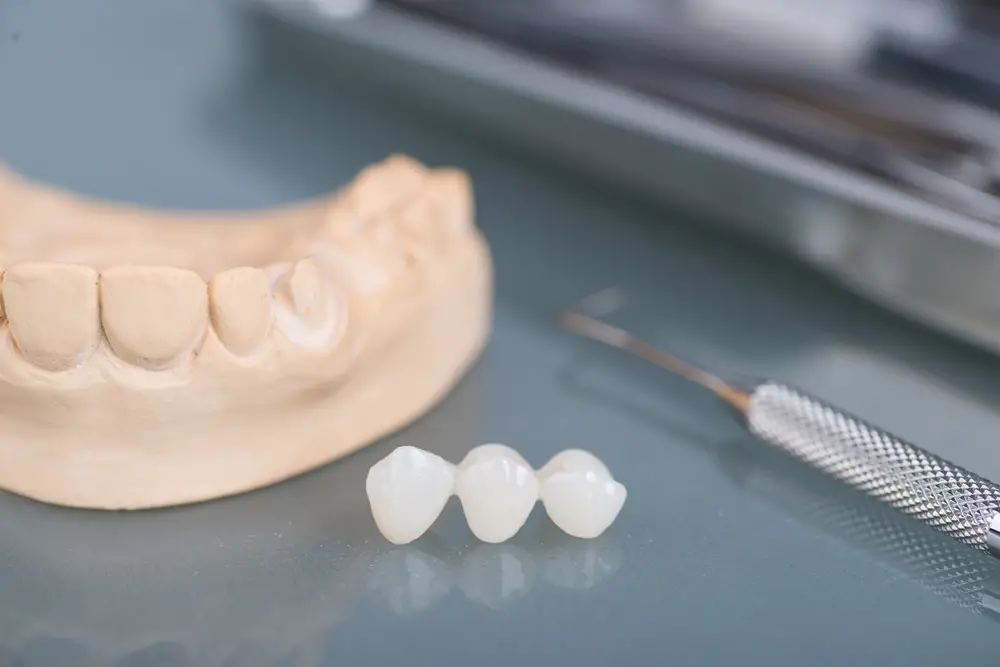A dental bridge is a fantastic way of covering up a gap in your teeth, but you should understand how to deal with any issues that arise due to this bridge. While it’s uncommon, one of the issues to prepare for is fixing a loose bridge at home.
In most cases, this involves using a temporary dental adhesive (like denture paste) to secure the bridge until you can get in for a more permanent fix. We strongly urge against the use of permanent adhesives when trying to fix this issue at home.
Fixing a loose dental bridge goes beyond adding something sticky and hoping for the best. You should be able to accurately assess your situation, determine the cause of the issue, and understand how to minimize the effects. We go over all of this below.
Signs Your Dental Bridge is Loose
It’s not always obvious that your dental bridge is loose. The major signs to watch for include:
- Movement
- Changes in or issues with your bite
- Tooth or gum sensitivity
- A foul taste and/or smell in your mouth
These can be signs of other issues, but it’s important to investigate any potential problem so you can address the issue as soon as possible.
Movement
Usually you can tell your dental bridge is loose when you detect movement or discomfort.
A dental bridge shouldn’t wiggle when you eat, drink, or touch it. While it’s rooted in your mouth like your natural teeth, there’s no reason for it to be flexible, and any movement needs attention.
Some more serious signs of a moving bridge include:
- Irritated gum
- Grinding on your other teeth
- Boils
- Signs of infection (i.e. fever or swelling)
It may be more difficult to detect these issues if your dental bridge is loose right off the bat. If something feels wrong, it’s better to bring it up than assume it will pass.
Bite Problems
Your dental bridge should facilitate a proper bite. Failure to do so will feel uncomfortable, causing issues like:
- Tooth pain
- Headaches
- Sore jaws
In some cases, you can simply tell there’s an issue by how it feels when you chew. Bite issues can be symptoms of other problems, none of which are okay to ignore.
Tooth or Gum Sensitivity
It’s normal for your mouth to be a bit sensitive after you have a dental bridge placed. Your teeth may need to adjust to accommodate the replacements, or your gums may need to accommodate implants or abutments.
Even so, this should only last a week and it shouldn’t occur randomly after this point. Persistent sensitivity or recurring pain is a sign that the implant is rubbing in a way it shouldn’t be.
Foul Taste or Smell
When seated properly, a dental bridge will not allow food or other bacteria to settle underneath. Odor or noticeable taste indicates that there is decay occurring under the bridge.
Depending on your situation, you may pick up on this in the early stages. Those less lucky will only realize there’s an issue after tooth decay sets in and starts to emulate. It’s essential to deal with this as soon as possible to prevent the development of gum disease or further damage to your teeth.
What Causes a Loose Dental Bridge?

The main reasons for a loose dental bridge are:
- Biting hard objects
- Poor dental habits
- Component failure
- Damage to the bridge or abutment teeth
Some of these are preventable, while others may occur at any time. If you already suspect your dental bridge is loose, this can help you determine what caused it and how you can prevent the problem from getting worse.
Hard Bites
While a dental bridge should let you eat whatever you want, some people experience problems biting down on hard foods like raw vegetables or hard candies. This usually ties to another issue, like damage to your bridge, but that doesn’t mean you can ignore this cause.
Once you notice a problem, avoid hard food until you can fix it.
Poor Dental Habits
Dental bridges aren’t susceptible to decay like natural teeth, but that doesn’t excuse you from brushing and flossing on a regular schedule. You may also need to add in a floss threader, interdental brush, or electric flosser to take care of your abutment teeth.
Poor dental habits allow for decay on the surrounding teeth, weaken your gums, and facilitate bone loss. This makes it difficult for your mouth to keep the false teeth in place. Poor oral hygiene can do a lot more than loosen your bridge.
Random Component Failure
Most dental bridges work perfectly fine, but there’s a chance you could end up with a faulty bridge or experience breakage of the bridge that compromises its position. Some examples of this include:
- Fractured abutments
- Fracture pontic
- Broken metal or porcelain framework
- Cement failure
Immediate dental bridge failure is unexpected, but talk to your dentist if you’re reaching the upper limits of your bridge. Cheaper materials like ceramic last about 10 to 15 years, and you may need a new bridge if you’re reaching this stage.
Damage to the Bridge or Abutment Teeth
Most damage to the bridge or supporting teeth happens because of trauma to your face or jaw. Just like your natural teeth, you should address any issues with your artificial teeth shortly after your face takes a hard hit.
Damage also occurs as time goes on. Regular exams can help you stay on top of this.
Fixing a Loose Dental Bridge at Home First (Temporary Fix)
Before we get into it, understand that fixing a loose dental bridge at home is temporary at best. This method is intended to provide relief and prevent further damage until your dentist can assess the situation and implement a permanent solution.
Because every situation is different, we recommend contacting your dentist to explain what’s going on. In most cases, they’ll tell you to do exactly what we do.
First, you want to clean the area to reduce the chance of sealing in any food or bacteria. Clean the bridge, gum, and teeth with a soft toothbrush and toothpaste, then rinse your mouth with warm saltwater. This should also help with any inflammation you’re experiencing due to the loose bridge.
Use a dental-specific OTC adhesive, like denture adhesive, to secure the bridge. This ensures easy removal and cleaning when you finally get in to see your dentist, and it prevents further damage to your teeth.
Once you have the adhesive applied, simply push the bridge into the correct position. Bite down to make sure everything is comfortable, and then do what you can to minimize future damage.
This include:
- Avoiding sticky or hard food
- Keeping your mouth extra clean
- Seeing your dentist as soon as possible
Let your dentist know if the problem gets worse. They may recommend you come in sooner or even see another dentist if they can’t get you in soon enough.
How to Handle Discomfort or Pain Until You Can See Your Dentist
While it’s not ideal, you’re likely to experience discomfort or pain at some point once your dental bridge comes loose. Securing the bridge should help a bit, but it’s not a perfect solution.
Warm saltwater is a great solution for anyone experiencing inflammation or gum agitation. You can also take over the counter pain relief medication, like Ibuprofen, or have your dentist prescribe a higher dose for more severe problems.
Plan on eating soft food that doesn’t require much chewing, at least until you can fix the problem permanently, and do what you can to minimize any pressure put on the bridge. If you’re known to grind your teeth, make sure you bring up this concern with your dentist.
How a Dentist Permanently Fixes a Loose Bridge
The way that your dentist ultimately fixes your loose bridge will depend on what caused the problem. Cement failure is probably the least invasive issue, in which case your dentist will break the existing cement, adjust the bridge, and readhere it.
It becomes trickier to solve when the cement doesn’t break easily or the structure of your abutment tooth is compromised. Your dentist may need to cut off the existing bridge, and install a completely new one.
In the worst situations they will remove the abutment teeth, and opt for an implant-supported bridge instead. This is why it’s so important to keep up with your normal dental care procedures.
Conclusion
While a loose dental bridge is not ideal, it’s usually a simple fix if you can get to the dentist. If you must take care of a loose dental bridge at home, remember to:
- Contact your dentist immediately for the most specialized care plan
- Keep the area as clean as possible
- Only use approved adhesives, like denture glue (or even sugar free gum), and NOT a household adhesive
In this situation, it’s most important to prevent further damage and achieve a permanent solution as quickly as possible.
Comment below if you’re unsure what’s causing your dental bridge issues or if you need help dealing with the problem.

